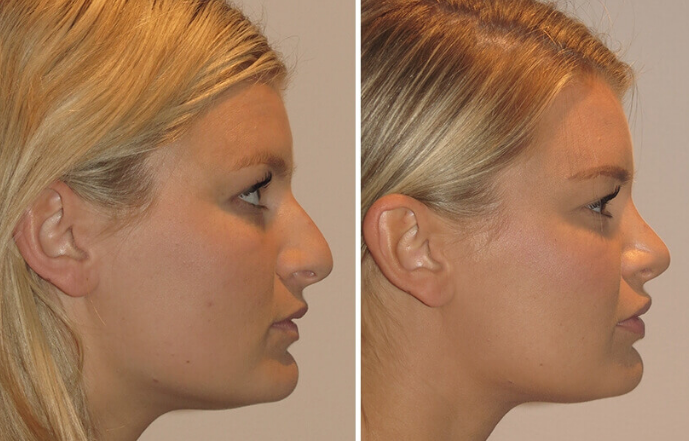Nose Implant in Romania
Search and Compare the Best Clinics and Doctors at the Lowest Prices for Nose Implant in Romania

Find the best clinics for Nose Implant in Romania
No clinics available
Thailand offers the best prices Worldwide
Price: $ 192

- Home
- Romania
WHY US?
At Medijump, we're making medical easy. You can search, compare, discuss, and book your medical all in one place. We open the door to the best medical providers worldwide, saving you time and energy along the way, and it's all for FREE, no hidden fees, and no price markups guaranteed. So what are you waiting for?

Free

Best Price

Widest Selection

Risk-Free
What you need to know about Nose Implant in Romania

Nose implant, also known as Augmentation Rhinoplasty, is a cosmetic surgery to change the shape of the nose by placing an implant. The procedure is mostly performed to bring balance to the face since the nose is the most noticeable part of the face. The procedure can be carried out to enhance appearance or repair deformities from an injury or correct a birth defect.
What does a Nose Implant Procedure Involve?
Nose implant can be carried out under general anesthetic or local anesthetic with sedation, depending on the complexity of the surgery and your surgeon's preference. The procedure may be performed through a small incision inside the nostrils (closed rhinoplasty) or through a small external incision at the base of your nose (open rhinoplasty). After making the incision, your doctor will place the implant, which may be synthetic (Gore-Tex, Silicone, Medpor) or autologous (from other parts of your body, such as cartilage from your rib). The final step is placing the nose’s skin and tissue into its original position and stitching up the incisions.
How Long Should I Stay in Romania for a Nose Implant Procedure?
If no complications arise, you should be able to leave the hospital on the same day. However, if general anesthesia is used during the surgery, you may need to stay overnight. After you are discharged from the hospital, expect to stay in Romania for 10 to 14 days to attend regular follow-up checkups.
What's the Recovery Time for Nose Implant Procedures in Romania?
You may experience swelling around your eyes, but this will gradually subside within 3 to 14 days. You should avoid strenuous activity (such as heavy lifting and intense exercise) for 3 to 6 weeks, but you may be able to return to work and some light activities in 1 to 2 weeks following the surgery. The full recovery time until your nose is completely healed is normally 6 months.
What sort of Aftercare is Required for Nose Implant Procedures in Romania?
After your surgery, you will need to keep your head elevated to prevent aggravated swelling. Do not blow your nose and avoid extreme facial expressions for at least 10 to 14 days following the surgery. Your doctor will give you a recommended diet plan, which may include high-fiber foods such as vegetables and fruits to avoid constipation since constipation can cause strain to the surgery site.
What's the Success Rate of Nose Implant Procedures in Romania?
Nose implant is known to have a high success rate of about 85% to 90%, particularly when performed by a certified plastic surgeon. Although the success rate is high, you need to be aware of the side effects and risks, such as bleeding, infection, difficulty breathing, permanent numbness around the nose, uneven-looking nose, pain, scarring, discoloration, septal perforation, and allergic reactions to the anesthesia.
Are there Alternatives to Nose Implant Procedures in Romania?
If you do not want to undergo surgery but you want to change the appearance of your nose, your alternatives are fillers and Botox, which are non-invasive. Both are injected into the skin of your nose to change its shape.
What Should You Expect Before and After the Procedure
Before the nose implant, you may not like the shape, size, or the overall look of your nose, your nose may look smaller or large on your face. After a nose implant, the size of your nose can be augmented and made proportionately to fit your face, which will improve your overall appearance.
Whilst the information presented here has been accurately sourced and verified by a medical professional for its accuracy, it is still advised to consult with your doctor before pursuing a medical treatment at one of the listed medical providers
No Time?
Tell us what you're looking for and we'll reachout to the top clinics all at once
Enquire Now

Popular Procedures in Romania
Prices Start From $404

Prices Start From $111

Prices Start From $70

Prices Start From $220

Prices Start From $1,945

Prices Start From $101

Prices Start From $101

Prices Start From $500

Recommended Medical Centers in Romania for procedures similar to Nose Implant

- Interpreter services
- Translation service
- Religious facilities
- Medical records transfer
- Medical travel insurance
- Health insurance coordination
- TV in the room
- Safe in the room
- Phone in the room
- Private rooms for patients available

- Interpreter services
- Translation service
- Religious facilities
- Medical records transfer
- Medical travel insurance
- Health insurance coordination
- TV in the room
- Safe in the room
- Phone in the room
- Private rooms for patients available

- Interpreter services
- Translation service
- Religious facilities
- Medical records transfer
- Medical travel insurance
- Health insurance coordination
- TV in the room
- Safe in the room
- Phone in the room
- Private rooms for patients available

- Interpreter services
- Translation service
- Religious facilities
- Medical records transfer
- Medical travel insurance
- Health insurance coordination
- TV in the room
- Safe in the room
- Phone in the room
- Private rooms for patients available

- Interpreter services
- Translation service
- Religious facilities
- Medical records transfer
- Medical travel insurance
- Health insurance coordination
- TV in the room
- Safe in the room
- Phone in the room
- Private rooms for patients available

- Interpreter services
- Translation service
- Religious facilities
- Medical records transfer
- Medical travel insurance
- Health insurance coordination
- TV in the room
- Safe in the room
- Phone in the room
- Private rooms for patients available

- Interpreter services
- Translation service
- Religious facilities
- Medical records transfer
- Medical travel insurance
- Health insurance coordination
- TV in the room
- Safe in the room
- Phone in the room
- Private rooms for patients available

- Interpreter services
- Translation service
- Religious facilities
- Medical records transfer
- Medical travel insurance
- Health insurance coordination
- TV in the room
- Safe in the room
- Phone in the room
- Private rooms for patients available

- Interpreter services
- Translation service
- Religious facilities
- Medical records transfer
- Medical travel insurance
- Health insurance coordination
- TV in the room
- Safe in the room
- Phone in the room
- Private rooms for patients available

- Interpreter services
- Translation service
- Religious facilities
- Medical records transfer
- Medical travel insurance
- Health insurance coordination
- TV in the room
- Safe in the room
- Phone in the room
- Private rooms for patients available
Nose Implant in and around Romania
Introduction
Situated at the crossroads of Central, Eastern, and Southeastern Europe, Romania is a country of contrasts. From its medieval towns and castles, nature, and wildlife, to its rich cultural heritage and amazing food, this country continues to amaze its visitors. In recent years, Romania has become a flourishing medical tourism destination. Due to its low prices, well-trained medical staff, highly skilled doctors, and amazing medical centers, the country attracts an ever-increasing number of international medical tourists. Dental work is the number one reason medical tourists travel to this country, closely followed by cosmetic surgeries. Most medical tourists come from other European countries, such as the UK, Germany, other Western European countries, and the US.
Popular Cities and Regions in Romania
Almost every city in Romania has its fair share of amazing tourist attractions and skilled specialists. The most popular one is the capital of the country, Bucharest. This dynamic city boasts excellent museums, trendy cafes, and beautiful parks. Tourists usually flock to the Palace of Parliament, the Statue of Emperor Trajan, Cişmigiu Garden, the Romanian Athenaeum, and the Museum of the Romanian Peasant. Besides Bucharest, one of the most popular cities in the country is Brasov which is located in Transylvania; tourists usually come to this city as their base for trips to “Dracula’s castle.” The city is filled with charming medieval streets, great hiking spots, and a beautiful historic center. The second-largest city in Romania, Cluj-Napoca, is also famous for its bohemian cafes, amazing medical centers, and music festivals.
Transport in Romania
Henri Coandă International Airport is the busiest airport in Romania. It serves flights to various major cities in Europe, Africa, and the Middle East. Getting around Romania with domestic flights is fast, but can be expensive. The most common way to travel is by bus and maxi taxi (minibus), which reaches even the smallest towns.
Visas in Romania
While Romania is not yet part of the Schengen Area, the country’s visa policy is based on the Schengen acquis. Therefore, citizens of 62 countries, including the US and Australia, can visit and stay in the country for up to 90 days without a visa. Citizens of other countries will need a visa to enter. Those who already have a Schengen visa may enter the country.
Weather in Romania
Spring from March to May has fairly mild temperatures and pleasant weather. Summer, starting from June to August, is usually dry, sunny and sweltering. Autumn comes in September and ends in November. It brings enjoyable temperatures, but it is also the rainy season in the country. Winter, from December to February, can get quite cold and harsh with frequent snowfall.
Additional Info
- Local Currency: The currency is the Romanian leu (RON). 1 USD is approx. 4.7 RON.
- Money & Payments: ATMs can be found in major cities and smaller towns. Credit cards are widely accepted in restaurants and hotels. Tipping is expected in restaurants, hotels, etc.
- Local Language: There are several spoken languages in Romania. However, Romanian is the most spoken language. English is also spoken by around 31% of the population.
- Local Culture and Religion: Romania is a secular state with no state religion. However, Christianity is the biggest religion. Islam, Paganism, and other religions are also present.
- Public Holidays: New Year’s Day, Descent of the Holy Spirit, National Day, and Christmas Day are some of the most celebrated public holidays.
Popular Searches
- Plastic Surgery in Thailand
- Dental Implants in Thailand
- Hair Transplant in Thailand
- Breast Augmentation Thailand
- Gastric Sleeve in Thailand
- Gender Reassignment Surgery in Thailand
- Laser Hair Removal in Bangkok
- Botox in Bangkok
- Dermatology in Bangkok
- Breast Augmentation in Bangkok
- Coolsculpting in Bangkok
- Veneers in Turkey
- Hair Transplant in Turkey
- Rhinoplasty in Turkey
- Stem Cell Therapy in Mexico
- Rhinoplasty in Mexico
- Liposuction in Mexico
- Coolsculpting in Tijuana
- Rhinoplasty in Korea
- Scar Removal in Korea
- Gastric Sleeve in Turkey
- Bone Marrow Transplant in India
- Invisalign in Malaysia
- Plastic Surgery in the Dominican Republic
- Tummy Tuck in the Dominican Republic
- Plastic and Cosmetic Surgery in Poland
- Rhinoplasty in Poland
- Hair Implant in Poland
- Dental Implants in Poland
- IVF in Turkey